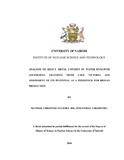Analysis of heavy metal content in water hyacinth (eichhornia crassipes) from lake Victoria and assessment of its potential as a feedstock for biogas production

View/
Date
2016Author
Matindi, Christine Nyawira
Type
ThesisLanguage
enMetadata
Show full item recordAbstract
Water hyacinth (Eichhornia crassipes) is an aquatic weed that exhibits prolific growth on the surface of water bodies and it is also a hyper accumulator of heavy metals. Over the past two decades Lake Victoria has been adversely affected by the plant which negatively impacted income generating activities as well as lake’s the ecology. The objective of this study was to evaluate the potential of water hyacinth as biomass for biogas production as a strategy to eliminate its threat on the lake and assess the heavy metal content in the weed. One hundred and eighty samples of the plant samples and 90 water samples were collected from 10 sites along Winam Gulf in Lake Victoria. For each sample, triplicate sub-samples for roots, stems and leaves were weighed, dried in room temperature followed by oven drying at 80 0C, then ashed at 600 0C and finally acid digested before analysis using TXRF. Water samples were analyzed directly using the same method. Bio-gasification was conducted in 6 m3 flexi tubular digester. Cow dung to water hyacinth ratios used were 1:1, 1:3 and 1:5 each having water ratio of 1:1. Twenty seven digestate samples were collected for analysis. These samples were prepared and analyzed in the same method as water hyacinth samples. Results showed the presence of manganese, iron, nickel, copper and zinc in water and which had as well been accumulated in the plant tissue. Highest recorded concentrations were Fe and Mn at 27812 ± 3.4 and 16691 ± 2.1 mg kg-1 respectively from roots. For water samples, the highest heavy metal concentration was Fe at 6931 ± 57 μg l-1. Order of occurrence for the metals in both water and water hyacinth samples and was found to be: Fe > Mn > Zn > Cu
> Ni. It was observed that the heavy metals were highly accumulated and retained in the roots in comparison to aerial parts and the order of accumulation was: roots > stems > leaves. Biogas volumes were recorded highest at cow dung: water hyacinth ratio of 1: 5 and least at cow dung: water hyacinth ratio of 1:1. The trend was similar in heavy metal concentrations for respective digestate analysis where highest concentrations ranged between 1427 to 1.7 mg kg-1 for 1:5 mixture and 1:1 mixture having the least range of concentrations between 505 and < 20 mg kg-1. When compared against heavy metal limits as specified by KEBS in 2011 for organic fertilizers, the quantities of heavy metals in the digestate does not exceed these limits and therefore can be applied as an organic fertilizer.
Publisher
University of Nairobi
Rights
Attribution-NonCommercial-NoDerivs 3.0 United StatesUsage Rights
http://creativecommons.org/licenses/by-nc-nd/3.0/us/Collections
The following license files are associated with this item:

